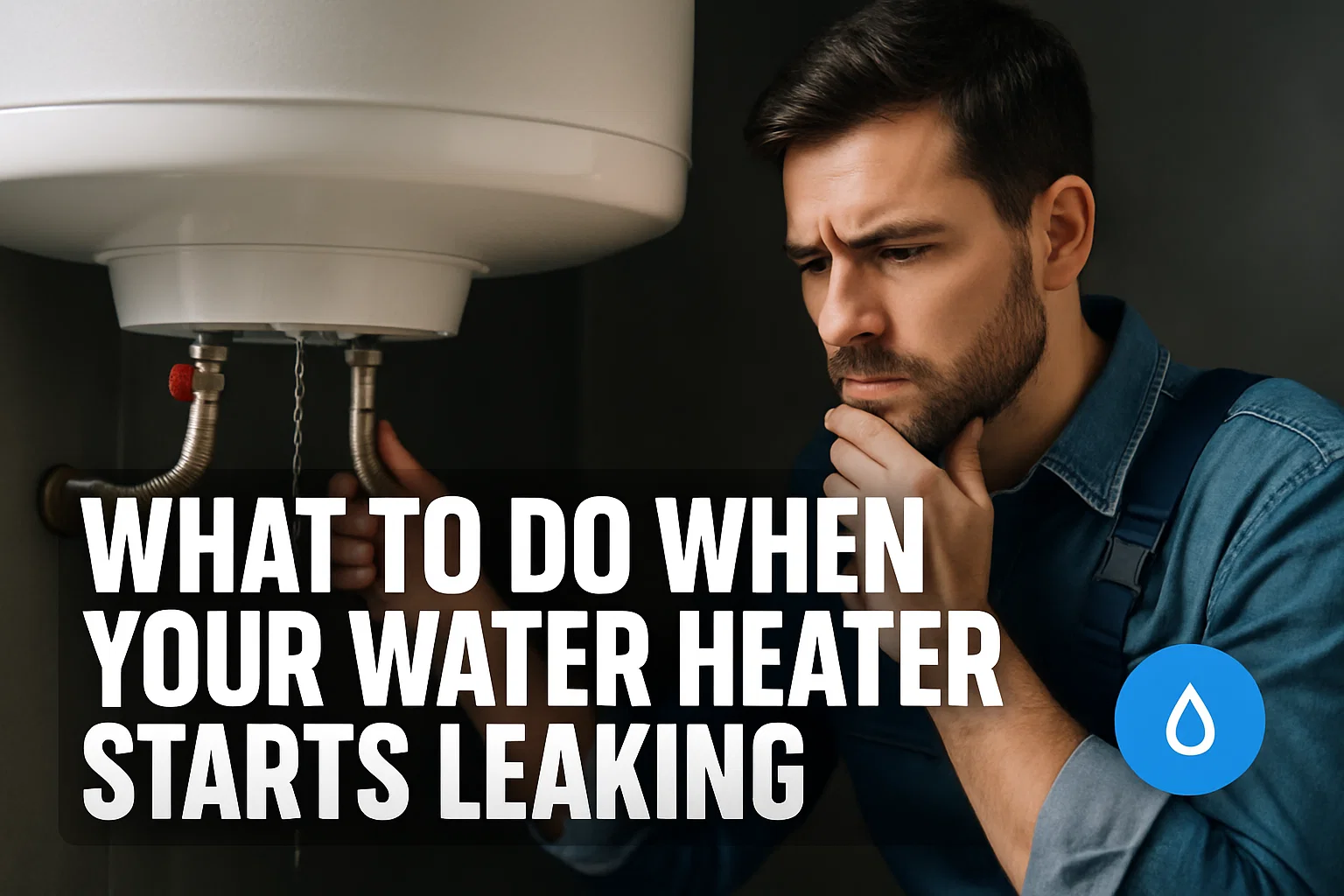Locating a leak in your water heater can be difficult, particularly in the beginning stages when damage is hard to assess and proper steps are not taken. Whether the water is dripping from pipes or pooling under the tank, even small leaks need to be handled immediately as they may point toward bigger issues down the road. In some scenarios, it shows that your appliance has reached its life span, while in others, it just entails simple issues.
Understanding the problem helps avoid overexpenditure on repairs water damage to your home’s plumbing system. In this guide, we will cover what to do when your water heater starts leaking and immediate actions you should take when dealing with leaking water heaters, so you will know when professional help is necessary.
Warning Signs Your Water Heater Is Leaking
You can miss many cues that indicate problems with the water heater, such as leaks. In most problems, there exists a hot water tank leakage that is often ignored. Consider these warning indicators:
- Water is pooling beneath the unit
- Rust or corrosion on the tank
- Condensation that doesn’t dry out
- A hot water tank leaking from the bottom
- Strange noises are coming from the heater
- Low hot water pressure or inconsistent temperature
Leakage spotted near the bottom part of the warm water receiver is a major sign of broken internal tanks, which require replacement rather than repair, suggesting failure modes based heating systems.
Is a Leaking Water Heater Dangerous?

A water heater that leaks doesn’t seem bad at first, but it can become very risky if left unattended. A leaking water heater poses a threat when it comes to damaging the building’s structure and any adjacent appliances. Moreover, if the appliance is located close to electrical parts of the house, then there’s the possibility of an electrical short-circuit or even fire.
Another concern is that it may create some pressure build-up inside the tank as well. In case the temperature and pressure relief (T&P) valve has stopped working or if the tank is filled with rust, this could increase excess pressure in the tank, which, on rare occasions, can cause tanks to burst. To put it simply, yes—it does pose a threat, especially when not fixed promptly. Hence, one should take measures the moment they find signs of leakage.
What to Do Immediately When You Notice a Leak
Here are the first steps that need to be taken when addressing leaking water heaters:
1. Turn Off the Power Supply
For electric units, the power must be turned off at the breaker; gas-powered heaters should be set thermostat “off” and close gas valves closed. These actions will avoid overheating and electrical hazards.
2. Water Supply Should Be Cut Off
Locate the cold water shutoff valve on top of the heater. Turning it off ensures water will no longer flow into the tank, thereby worsening any existing leaks.
3. Tank Drainage (If Applicable)
In case of significant leaks, it’s advisable to attach a hose to the tank’s drain valve and direct it towards a floor drain or a bucket. This protects against further damage as well as enabling safer inspection.
4. Inspect for Source Leak
Conduct inspections on whether the leak is from a fitting, valve, or the tank itself. This enables you to decide whether to repair or replace.
Common Causes of a Leaky Water Heater
Different issues can lead to having a water heater leak, ranging from less critical issues to more problematic ones. Identifying the reason helps in determining steps that need to be taken in order to control and prevent damage from happening in the future. Leaks can either be due to loose fittings or worn-out components, but there are cases where signs of failure mean possible full replacement, which needs close evaluation.
Loose Drain Valve
A water heater dripping might lead one to think there are more severe underlying problems when, oftentimes, an overlooked reason, such as a partially open or deficient drain valve, causes bottom leaking.
Faulty Temperature and Pressure Relief Valve
Discharge from the T&P valve could signify both over-temperature conditions, excessive pressure buildup, or systemic malfunction that may risk system safety.
Tank Corrosion
Hot water tank leaks are often evidence of internal corrosion, where the structure weakens progressively due to ongoing rusting.
Sediment Buildup
Contaminants associated with hard water have the potential to lead to overheating and eventual failure of the tank by cracking it. In most cases, this will result in leaks as time progresses.
Water Heater Lifespan
Leaking tanks that are older than approximately 8–12 years ought to be replaced instead of repaired, as replacement would most likely be cheaper.
When to Repair vs. When to Replace
Only some issues resulting in leaking can indicate saving options beyond simple fixes, while others suggest a systematic failure requiring full replacement. Below is a quick table for repair vs replace, including cost estimation for both scenarios.
| Condition | Repair or Replace | Cost |
| Loose or damaged drain valve | Repair | $75 – $150 |
| Faulty temperature & pressure (T&P) valve | Repair | $100 – $250 |
| Water is leaking from the bottom of the tank | Replace | $800 – $2,000+ |
| Corrosion or rust on the tank | Replace | $900 – $2,500 |
| Unit older than 10–12 years | Replace | $1,000 – $2,500+ |
| Multiple leaks or recurring water pooling | Replace | $1,000 – $2,500+ |
When to Call a Professional
In many cases, homes have minor water heater problems that require only maintenance. However, some issues may require professional help. Knowing when to call an expert plumber can help save time and damage while keeping the home secure. A water heater leak may seem easy to resolve; however, it presents a significant risk due to underlying problems with gas lines, pressure valves, or internal corrosion.
Persistent Hot Water Leaks

If your apparatus still leaks water out even after you tighten everything and cut the supply to it, or drain it. It is a sign of more serious underlying issues mechanically or structurally. Consistent leaks suggest an irreparably damaged tank or corrosion that has progressed significantly. They do require attention, but repeating temporary patching can delay a complete breakdown. These scenarios need specialized attention first from diagnosis and then treatment based on findings, so that matters do not escalate.
Gas Hot Water Heater Leaking Risks
Gas burners create water heater fractures, which can be significantly more dangerous due to fires. A seemingly insignificant leak in a water powered by natural gas can serve as a source of light, fire burning, smoke fumes and without proper attention can become natural gas pistons if they flow into parts where wires are placed; At this part trained person needs to step in who knows well about how to fuse, separate and combining electricity, water and gases safely.
What to Do If You Turned Off Water, But Hot Water Tank Still Leaking
In the event that your hot water tank is leaking despite the fact that you’ve turned off the water supply, there are multiple potential issues. Most likely, the leak is caused by pressurized water in a storage tank or by slipping cracks out of reach due to an internal malfunction or a broken relief valve. From the moment you start noticing leaks while shutting off valves, it would be wise to contact a plumber, as additional delays may flood your area, cause serious water damage, restoration or completely rupture your tank.
Conclusion:
Ignoring your leaking water heater will only put you in more trouble. While there are many minor fixable issues, some leaks indicate severe problems that may need the replacement of parts. If addressed quickly, both time and money can be saved, along with protecting property and ensuring safe access to hot water whenever required. Always seek help from certified plumbers, especially when components like heat and power are involved in one unit.
FAQ’s
External leaks in water heaters can be dangerous as they can cause severe electrical damage, water damage, or even lead to pressure hazards.
This could be due to tank corrosion and a drain valve failure, both of which would necessitate replacement.


















